For those of you who are not familiar with Bob Ross, he was a painter who had a television show on public television from 1983 to 1994. On his show he would give basic tutorials on how to paint simple landscapes in a very calm manner. In recent years Bob Ross has become a sort of internet celebrity as his old tutorials have resurfaced online which included Twitch re-airing all of the episodes from his show over a nine day marathon. Bob Ross’ recent reemergence has lead to a surge of Bob Ross themed merchandise which actually includes two board games. One of those board games is the game I am looking at today, Bob Ross Art of Chill. Usually when a board game is based on a franchise or trend, it is not very good. The games are usually really rushed to try and make a quick buck. Bob Ross Art of Chill though seemed different as real work seemed to be put into designing the game. It also had an odd similarity to my favorite board game of all time Ticket to Ride. Bob Ross Art of Chill owes a lot to games like Ticket to Ride, but distinguishes itself enough that is is way better than you would ever expect a Bob Ross game to be.
How to Play Bob Ross Art of Chill
Setup
- Unfold the easel and set it up where everyone can see it.
- Place the gameboard in the middle of the table.
- Shuffle the chill cards and place them face down on the corresponding spot on the gameboard.
- Each player chooses a color. They will take the corresponding palette, chill cube, and three feature markers. Each player will place their chill cube on the zero space of the chill meter.
- Shuffle the technique cards and place them face down below the gameboard. Then take the top four cards from the deck and turn them face up next to the deck.
- Shuffle the art supplies cards. Deal three cards to each player. Players can look at their cards but shouldn’t show them to the other players. Place the rest of the cards in a face down pile. Take the top four cards from the deck and turn them face up next to the draw deck.
- Shuffle the paintings and place them in a stack next to the easel. Turn over the top painting in the stack and place it on the easel. Place the Bob mover on the first space on the left side of the painting.
- The player who has most recently painted a picture will start the game. Play will proceed clockwise.
Playing the Game
A player’s turn consists of two stages:
- Roll the Die
- Perform Actions
After a player completes both stages, play passes to the next player clockwise.
Rolling the Die
A player will begin their turn by rolling the die. Depending on what the player rolls they will take a special action.
Palette: You may take one of the paint cards from your hand and play it to your palette.
Art Supplies: You may take the top card from the art supplies draw pile.
Hand: You may take one additional action during your turn (see below).
Bob
If you roll the Bob symbol you will take two actions. First you will turn over the top chill card and place it face up on the discard pile. This will cover up any previously played chill cards. If the card says “When this card is revealed” the card’s effect will be taken immediately. All other chill cards have a lasting effect that remains until it is covered up by another card.
You will then move the Bob mover along the painting one space to the right (unless the chill card says not to).
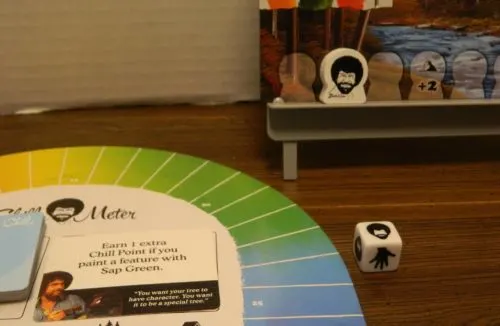
This player has rolled the Bob Ross symbol. First they drew the top chill card. The chill card awards players an additional point if they paint a feature using Sap Green. The player then moves the Bob marker forward one space along the painting.
Performing Actions
In this stage you will get to perform three actions (unless modified by what you rolled or a chill card). You can choose which actions you want to perform. You can perform them in any order and you may perform the same action multiple times. The actions you can perform in this stage are:
- Draw an Art Supplies Card
- Add Paint to Your Palette
- Wash Your Palette
- Sweep the Art Supplies Cards
- Earn a Technique Card
- Paint a Feature
Draw an Art Supplies Card
When you choose this action you will draw an art supplies card and add it to your hand. You may either take one of the face up cards or the top card from the draw pile. If you draw one of the face up cards, you will replace it with the top card from the draw pile. There is no limit on how many art supplies cards you can have in your hand. Each card you draw though counts as one action.

If this player wants to draw a card they can choose one of the face up cards or the top card from the draw pile.
Most art supplies cards have both a paint color and a brush. These cards can be used as either the paint color or the brush. Wild cards feature all of the colors on the card. They can be used as any one color to either claim a technique card or paint a feature. If the wild card is face up on the table it will take two of your actions in order to pick up the card. If you draw a wild card when it is face down in the draw pile, it only counts as one action.
Apply Paint to Your Palette
For one action point you can play one of the paint cards from your hand to either the A or B side of your palette. Each paint area can hold up to three paints. When two paints are played to the same side of the palette they are considered to be mixed. When two or three paints are mixed they can only be used if all of the paints are used in the feature that the player is trying to paint.
Wash You Palette
If you would like to either clean the A or B side of your palette you can use one action point to remove all of the paint cards from that side of the palette. These cards are discarded. If you want to wash both sides of your palette you will have to use two action points.
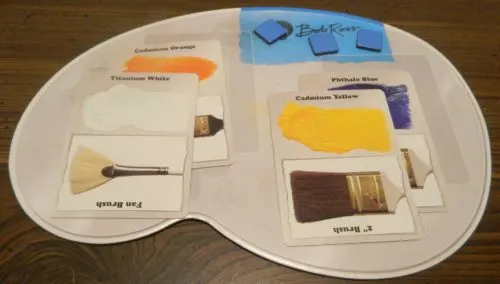
If this player doesn’t like one of the sides of their palette they can use one action point to either discard the white and orange card or the yellow and blue card. To discard both sets of cards the player will have to use two action points.
Sweep The Art Supplies Cards
For one action point you may take the four face up art supplies cards and discard them. The cards will then be replaced with the top four cards from the draw deck.

If the player doesn’t want any of these face up art supplies cards, they can use one action to discard them and turn over the next four cards.
Earn a Technique Card
In order to take one of the face up technique cards you will have to use one of your action points. You will also have to discard two cards from your hand that match the technique card that you are trying to acquire. When you claim the technique card it will be placed in front of you. The next technique card is turned up to replace the card you claimed. You will also get to move your chill cube forward two spaces on the chill meter.
Paint A Feature and Scoring
The final action that you can perform on your turn is to paint one of the features on the painting. Each feature you paint costs one action point. Players can paint the features in whatever order they prefer. They can even paint a feature after another player or Bob has painted it. A player can only paint each feature once for each painting though.
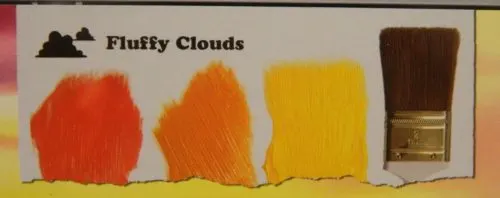
This player wants to paint the fluffy clouds. In order to paint the fluffy clouds they will need on their palette the three paints, and will need to play the corresponding paint brush.
In order to paint a feature you need to have all of the paints on your palette that match the feature that you want to paint. The paints used for the feature can be split between the A and B side of your palette. If paints are mixed though, all of the mixed paints must be used in the feature or none of the paints on that side of the palette can be used. The player also needs to have the appropriate brush card in their hand. To paint the feature you will discard the corresponding brush card from your hand. You will also discard all of the paints you used from your palette.
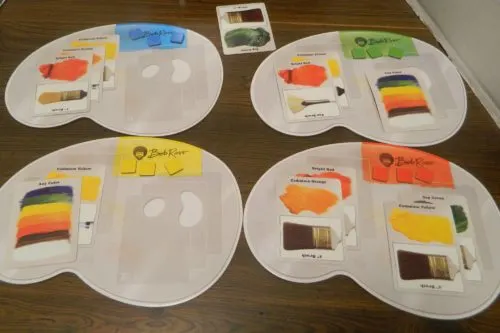
Here are four players that are trying to paint the fluffy clouds. To paint the fluffy clouds all of the players would have to play the brush card at the top of the picture. The player in the top left would complete the fluffy clouds as they have all of the paints on their palette. The player in the top right could paint the clouds as well as they have all three necessary colors (the wild is filling in for the missing color) spread between the two sides of their palette. The player in the bottom left couldn’t paint the clouds as they don’t have all of the necessary colors. The player in the bottom right also couldn’t paint the clouds as they can’t use the yellow since the green that is on the same side of the palette is not included in the fluffy clouds.
After you paint a feature you will score points based on a couple things:
You will score points equal to the number of paints used in the feature.
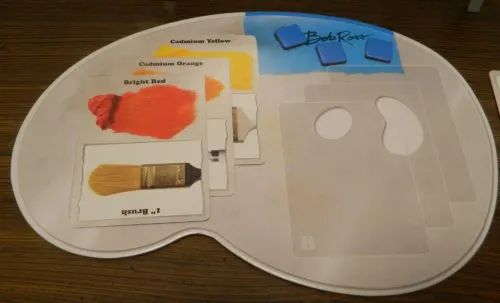
This player used three paints while painting the feature. They will score three points from the paints.
Once you paint a feature you will place one of your feature markers on the top unoccupied space on the gameboard under the feature you painted. If you were the first to paint the feature you will score two additional points. If you were the second to paint the feature you will score one additional point. Any player after the second player will score no additional points.
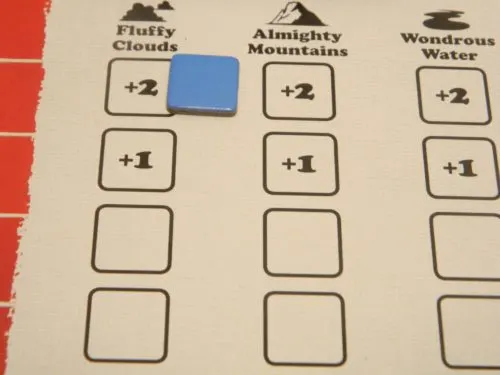
The player completed the fluffy clouds so they will place one of their markers on the top space in the corresponding column. As none of the other players have painted the feature yet, they will score two bonus points.
On the painting there will be various symbols corresponding to each feature along the bottom of the painting. If you complete a feature before the Bob marker reaches the corresponding symbol, you will score the bonus points shown next to the symbol.
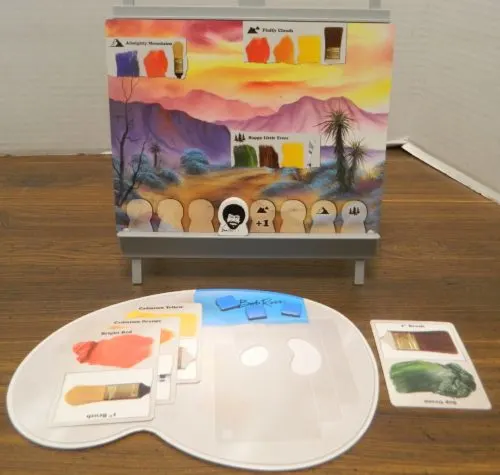
Looking at the track on the bottom of the painting, the player completed the fluffy clouds before Bob Ross. As shown on the track, the player will score one bonus point.
If the feature you painted matches the bonus on the current Chill card, you will score the corresponding number of points.
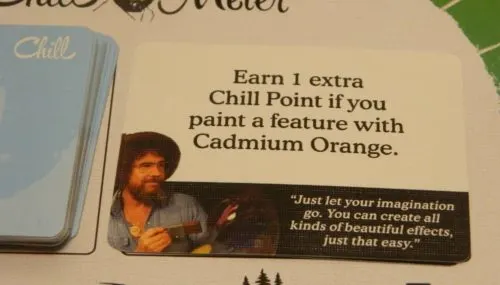
The player painted the fluffy clouds using Cadmium Orange. This player will score a bonus point for using Cadmium Orange.
Check all of the technique cards that you have acquired. You will score one additional point for each technique card that you have that matches one of the paints or brush used in the feature.
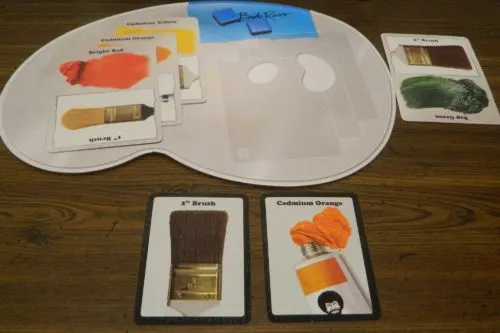
This player has the technique card for the 2″ Brush and Cadmium Orange. As these were used in the painted feature, the player will score two bonus points.
Finishing a Painting
A painting can be finished in one of two ways.
If the Bob marker moves to the last space on the Bob track, the painting is immediately completed by Bob.
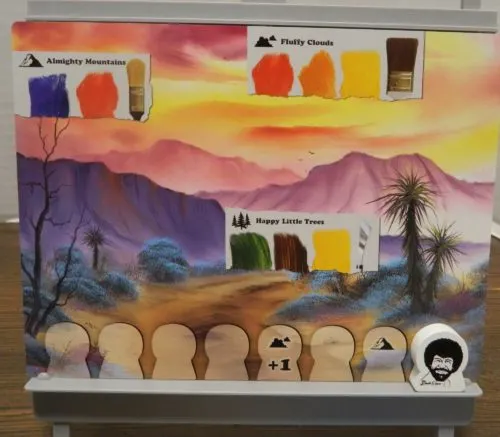
The Bob Ross marker has reached the end of the track on the current painting. The current painting has been completed by Bob.
If one player completes all three features of the painting, the painting is also completed.
When a painting is completed the game is halted. If the player just painted a feature, score the feature for the player. The following steps are then followed:
- The painting is removed from the easel. The top painting card from the stack is then flipped over and placed on the easel.
- The Bob marker is moved back to the first space of the track on the new card.
- All feature markers are returned to the corresponding players.
The game then resumes where it left off.
End of Game
The game ends immediately when one player’s chill cube reaches the chill space on the board. This player has won the game.
My Thoughts on Bob Ross Art of Chill
Heading into playing Bob Ross Art of Chill I didn’t know what to expect. As Bob Ross was known as a painter most people would assume the game would be some sort of Pictionary style game where you would draw/paint. As I began reading the instructions one thing quickly became apparent. The game immediately started to remind me of my favorite board game Ticket to Ride. What does a train game where you claim routes have to do with a game based on a television painter? For some reason a surprising amount. Despite the themes being so different, the Ticket to Ride style gameplay works surprisingly well with the Bob Ross theme.
While Ticket to Ride is probably not a perfect comparison, it is surprisingly fitting. The two games share a very similar core. In Ticket to Ride you are trying to claim different train connections in order to complete routes. In Bob Ross Art of Chill you are trying to complete various sections of paintings. These might not sound very similar, but the mechanics of how you accomplish these tasks are very similar. The heart of both games is card management. A lot of the game involves you drawing cards and playing cards to claim connections or complete parts of the painting. The drawing mechanics in Bob Ross Art of Chill are pretty much exactly the same as Ticket to Ride.
Where things differ regards playing cards. In Ticket to Ride you are trying to accumulate a lot of cards of the same color in order to acquire connections. In Bob Ross Art of Chill you are trying to acquire different color paints as each section of the painting requires different colors. This doesn’t change the gameplay a lot as you are just targeting different types of cards.
The second area where playing cards differs from Ticket to Ride is that the competition to claim features is not as intense. In Ticket to Ride once a player claims a connection it is taken for the rest of the game and no one else can claim it. In Bob Ross Art of Chill all of the players can claim the same feature. In some ways I like this change and in other ways I don’t.
On the positive side it makes the game a little less stressful. In Ticket to Ride the game can become kind of stressful when you need a specific connection in order to complete a route. You never know when another player is going to claim it though. It can be frustrating when a player claims a connection a turn before you can get it thus ruining your plan. This is less stressful in Bob Ross Art of Chill as you just lose a point or two if another player beats you to a feature. That is unless Bob completes the painting before you can finish a feature. If Bob Ross finishes a painting right before you were about to paint a feature, it will really hurt your chances of winning the game. Unless you get lucky and the next painting needs the exact same combinations of colors as the previous painting, you will likely end up wasting some of your paints. This is weird as it kind of makes Bob Ross the “villain” in the game. My personal advice it to try and avoid painting any features when Bob Ross is close to reaching the end of the track.
On the negative side though, with smaller stakes this part of the game is not quite as exciting. One of the best parts of Ticket to Ride is being able to steal a connection right out from another player. This eliminates most of the urgency to painting a feature earlier to prevent another player from taking it. You mostly need to just worry about painting a feature before the painting is completed.
The final way that playing cards differs in Bob Ross Art of Chill is actually responsible for most of the differences between the two games. In Ticket to Ride you need to just collect cards and then use a turn to play the cards and claim it. Bob Ross Art of Chill adds another step to this process. Instead of just playing cards to claim a feature, you need to first play them to your palette. In some ways I liked this mechanic and in other ways I didn’t like it.
On the positive side it adds some interesting strategy to the game. When you add paints to your palette you need to be careful on how you add them. You only have two sides to your palette so you need to use them properly. Most of the features in the game require you to only use three paints. You can place all three of these paints on the same side so it is not a big issue. Some of the features require four paints though. This requires you to use both sides of your palette. You need to be careful how you place the paints though due to the mixing rules. You need to place cards so you will be able to use them with all of the other paints placed on the same side of the palette. This requires some planning so you don’t have to later waste an action to clear your palette.
There are two things that I didn’t really like about the mechanic though. First it adds a little complexity to the game. It will take some players a little while to understand the mixing mechanic and figure out what cards they can use to paint a feature. The bigger problem though is that you have to waste too many actions applying all of the paint to your palette. I actually really liked the addition of action points that Bob Ross Art of Chill uses. When you want to paint a feature though you have to use way too many actions. As you usually need three paints to complete a feature, you will be using at least one turn to just apply the paint needed for a feature. You also need to spend a turn acquiring the paint cards. Therefore it usually takes at least two and a half turns to complete any feature between acquiring the cards, adding them to your palette, and then finishing the feature. As this process takes so long it tips off the other players to what you are planning to do. You also have to worry about the painting being finished before you can complete the process.
While I don’t like that you have to waste so many actions adding paints to the palette, I really liked the addition of action points to the game. This gives you more choices in how you want to approach the game. This is especially true when it comes to technique cards. In Bob Ross Art of Chill there are two ways to approach scoring points. First you can mostly focus on painting features. The other way to score victory points is focusing on getting technique cards. Each technique card you acquire scores you two points. The bigger benefit is that the technique cards will score you a bonus point for each feature you paint that includes the paints/brushes from the technique cards you own. If you spend a lot of time acquiring technique cards early in the game, you can score massive bonus points by painting features later in the game. In general I really liked the addition of technique cards even though I think they are a little overpowered.
Just like the game that it was heavily inspired by, Bob Ross Art of Chill does a great job finding the right balance between being easy to learn and yet having enough strategy. While not as simple as Ticket to Ride, Bob Ross Art of Chill is simple enough that it can be taught in five to ten minutes. For a couple turns new players might not know exactly what they are doing, but they should be able to grasp the gameplay pretty quickly. This simplicity is supported with enough strategy where the game will be enjoyable for both players who rarely and regularly play board games.
So I have spent most of this review comparing Bob Ross Art of Chill to Ticket to Ride. So how does it ultimately compare to Ticket to Ride? At the end of the day it doesn’t quite live up to Ticket to Ride. That is a tall order though as Ticket to Ride is my favorite board game of all time, and I have played around 800 different board games. There are a few areas where I actually think Bob Ross Art of Chill is better than Ticket to Ride, but there are more areas where it is worse. While it might not be quite as good, fans of Ticket to Ride and other similar games should really enjoy Bob Ross Art of Chill.
On top of the gameplay I think the game’s components are also really nice. The cards and cardboard pieces are made of solid cardboard. The art design is great. The components are also well designed where you can easily find whatever you need. On top of all of this the paintings are actual Bob Ross paintings and they look really good. There really isn’t anything to complain about when it comes Bob Ross Art of Chill’s components.
While I enjoyed Bob Ross Art of Chill Game, I did have a few issues with the game.
The biggest issue with the game regards the die. The die is mostly used to advance the Bob token along the track and add a little randomness to the game. I don’t mind the role of moving the Bob marker along the track even though the Bob symbol is rolled far too often. It seems like the symbol is rolled more than the 50% that it should statistically be rolled. The problem is that the die adds quite a bit of luck to the game. I don’t mind the fact that you get different random abilities from the die with some being better than the others. The problem is that when you roll the Bob symbol you are put at a distinct disadvantage. Bob moving along the track and the chill cards impact all of the player’s equally. The problem is that the players who roll the Bob symbol don’t get an additional special action on their turn. This can add up if one player regularly rolls the Bob symbol while other players roll other symbols.
For this reason I think this mechanic needs to be tweaked in some way. First I could see basically ditching the die altogether. You would still roll the die but ignore all of the symbols other than the Bob symbol. This would keep moving Bob along the track without putting anyone at a disadvantage. Otherwise you should give the players who roll a Bob symbol some sort of special ability.
The other issue I had with Bob Ross Art of Chill is that it just feels like you end up not doing a whole lot in the game. I actually like the game’s overall length as at 30-45 minutes it is not too short or long. This length also makes it so most games should be pretty close. Unless you make a terrible decision or have horrible luck, most players should be pretty close to winning the game themselves when the game ultimately ends. The problem is that you don’t actually end up getting much accomplished in the game.
I think this is due to a couple things. First it is not that hard to score enough points to win the game. You only have to complete a few features or acquire a lot of technique cards in order to win the game. In most games you will probably only go through three or so paintings. The other problem is that even with three action points you can’t get that much done in a turn. As I mentioned earlier you need to use two and a half turns just to complete a feature. For this reason it feels like the game ends as quickly as it begins. I honestly think the game should have given you more action points each turn as well as requiring you to score more points in order to win the game.
Should You Buy Bob Ross Art of Chill?
I was skeptical when I first found out that there were board games based on Bob Ross as I thought they were just going to be quick cash grabs with little effort put into making an actual good game. That opinion changed quickly as I could tell the designers tried to make Bob Ross Art of Chill a good game. Even if you aren’t a fan of Bob Ross, the game is a genuinely good game. It actually reminded me a lot of Ticket to Ride as you acquire paints in order to complete various features of the current painting. The game does a great job finding the right mix between being accessible and yet having enough strategy to keep people interested in the game. It isn’t quite as good as Ticket to Ride, but it has its own unique mechanics. The only issues I had with the game is that it relies on a little too much luck and it doesn’t feel like you get a lot accomplished in the game.
If you don’t like Bob Ross or don’t really care for games like Ticket to Ride, I probably wouldn’t recommend Bob Ross Art of Chill. If you like Ticket to Ride I think you will like the game quite a bit. Fans of Bob Ross should also appreciate the game as it does a good job with the theme while also being a good game. For most people I think Bob Ross Art of Chill is a great purchase as it is a lot better than you would expect it to be.
If you would like to purchase Bob Ross Art of Chill you can find it online: Amazon, eBay

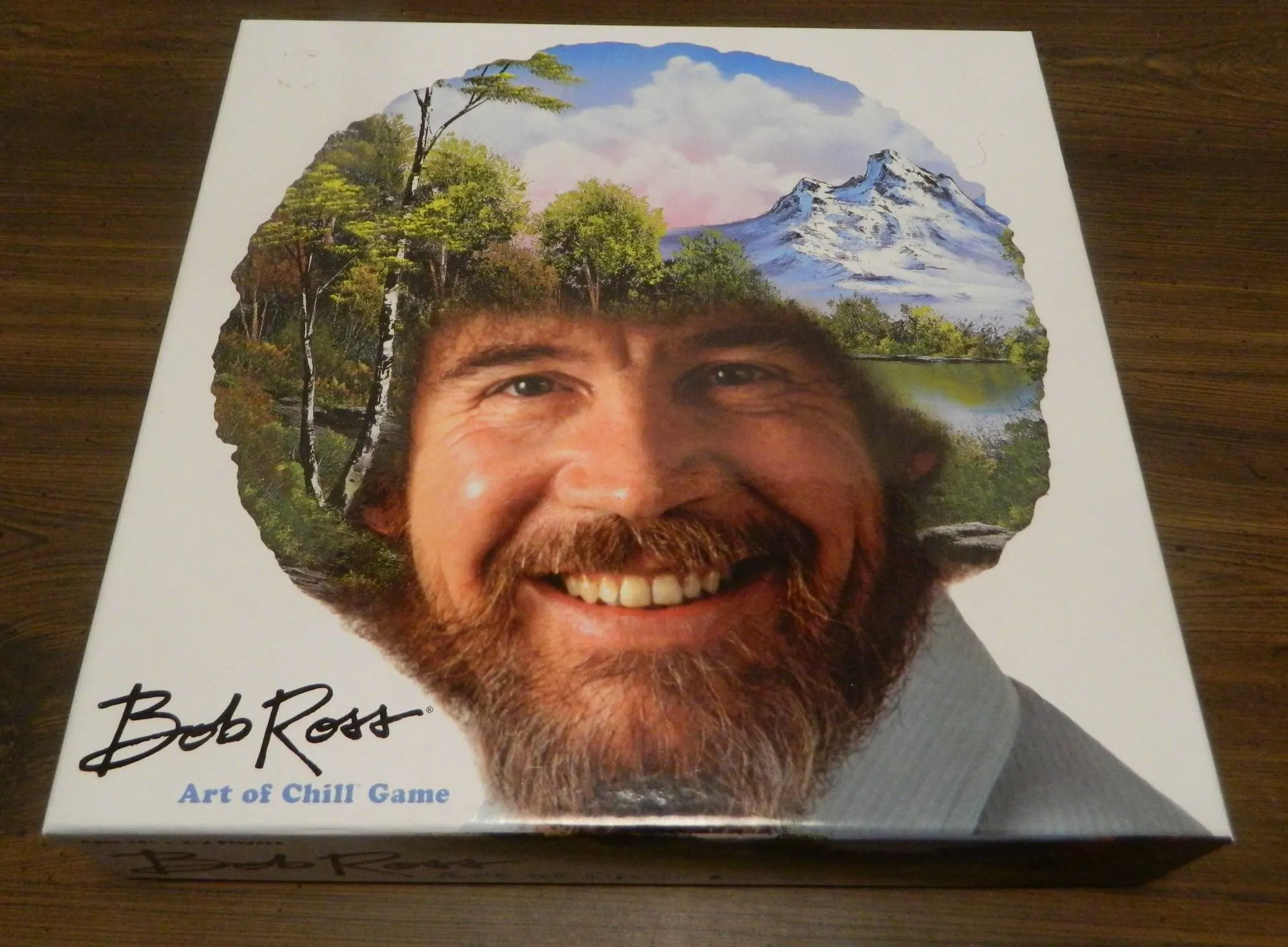
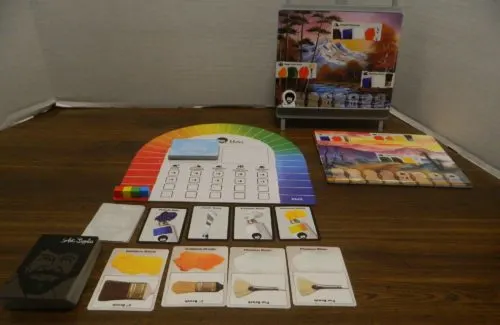
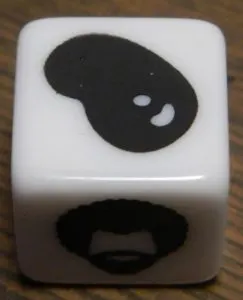
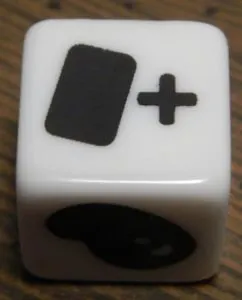
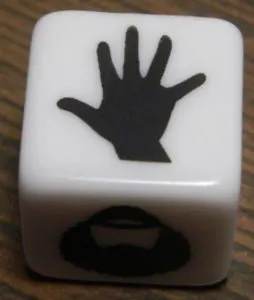
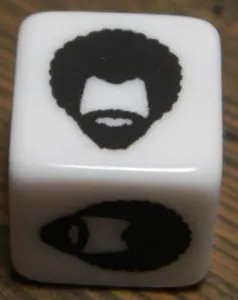
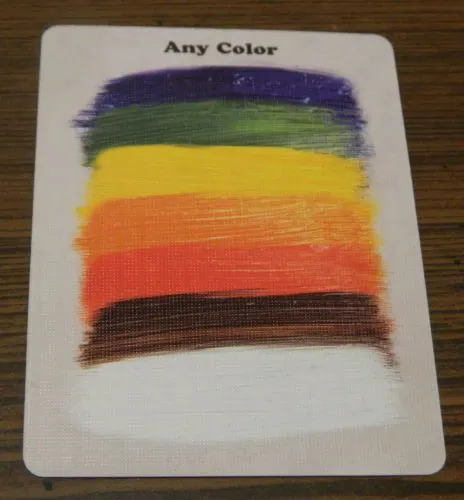
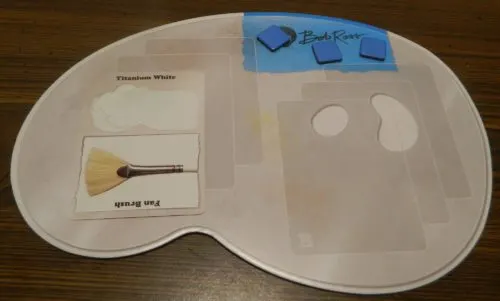
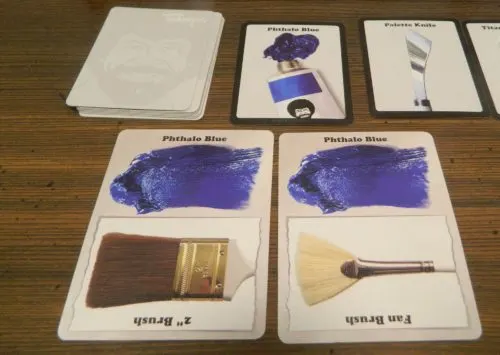
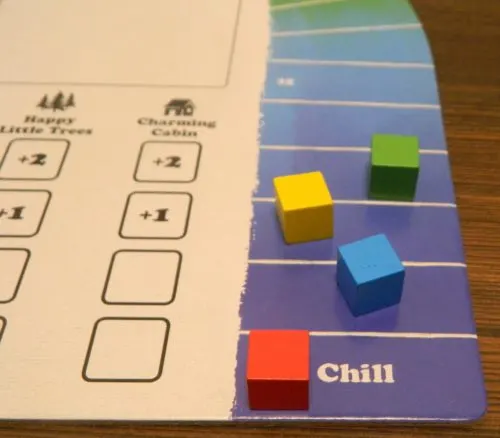
Ricardo
Saturday 29th of February 2020
a question related to the rules:
to put on the pallet a technical card, is an action used?
Eric Mortensen
Saturday 29th of February 2020
I am not exactly sure what you are asking with regards to a technical card.
If you meant a technique card, once a technique card is acquired it is set in front of you for the rest of the game. After you acquire one of these cards they will be active for you for the rest of the game without you having to take any other actions. When you paint a feature you reference the technique cards that you have acquired. If you have a technique card that matches one of the colors or the paint brush you used in your painting you will score one bonus point. Referencing these cards does not count as an action.
If you are talking about playing a card as a brush these cards will never be added to the palette. When you have all of the paints on your palette for the feature you are trying to paint you will then use an action to paint the feature. Part of the action to paint the feature involves playing the corresponding brush card so it costs a total of one action point to paint a feature and score the points for that action.